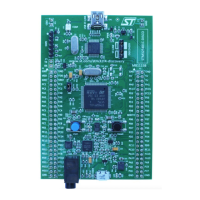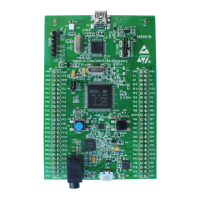RM0402 Rev 6 975/1163
RM0402 USB on-the-go full-speed (OTG_FS)
1122
Figure 336. OTG_FS peripheral-only connection
1. Use a regulator to build a bus-powered device.
29.6.1 SRP-capable peripheral
The SRP capable bit in the Global USB configuration register (SRPCAP bit in
OTG_GUSBCFG) enables the OTG_FS to support the session request protocol (SRP). In
this way, it allows the remote A-device to save power by switching off V
BUS
while the USB
session is suspended.
The SRP peripheral mode program model is described in detail in the B-device session
request protocol section.
29.6.2 Peripheral states
Powered state
The V
BUS
input detects the B-session valid voltage by which the USB peripheral is allowed
to enter the powered state (see USB2.0 section 9.1). The OTG_FS then automatically
connects the DP pull-up resistor to signal full-speed device connection to the host and
generates the session request interrupt (SRQINT bit in OTG_GINTSTS) to notify the
powered state.
The V
BUS
input also ensures that valid V
BUS
levels are supplied by the host during USB
operations. If a drop in V
BUS
below B-session valid happens to be detected (for instance
because of a power disturbance or if the host port has been switched off), the OTG_FS
automatically disconnects and the session end detected (SEDET bit in OTG_GOTGINT)
interrupt is generated to notify that the OTG_FS has exited the powered state.
In the powered state, the OTG_FS expects to receive some reset signaling from the host.
No other USB operation is possible. When a reset signaling is received the reset detected
interrupt (USBRST in OTG_GINTSTS) is generated. When the reset signaling is complete,
the enumeration done interrupt (ENUMDNE bit in OTG_GINTSTS) is generated and the
OTG_FS enters the Default state.
MSv36916V2
OSC_IN
OSC_OUT
GPIO
GPIO + IRQ
V
DD
EN
Overcurrent
5 V to V
DD
Voltage
regulator
V
DD
5 V Pwr
VBUS
DM
DP
V
SS
STMPS2141STR
Current-limited
power distribution
switch
(1)
USB micro connector

